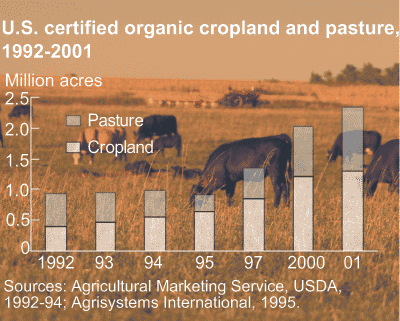Organic Agriculture: Gaining Ground
- by Catherine Greene and Carolyn Dimitri
- 2/3/2003
Organic agriculture is expanding rapidly in the United States, as consumer interest continues to gather momentum and new organic production and marketing systems evolve. In the wake of USDA's implementation of national organic standards in October 2002, continued growth in the industry is expected.
USDA's organic rules incorporate an ecological approach to farming that has evolved over the last half-century. Farmers developed rigorous standards and management-intensive production systems for organic farming during this period. Before USDA implemented its national organic standards, many States and most organic distributors required third-party certification to ensure that organic farmers adhered to organic production standards. USDA's new rules make certification according to the national standards mandatory.
Despite the time, costs, and effort required to meet these stringent requirements, farmers and ranchers added a million acres of certified organic land for major crops and pasture between 1997 and 2001, doubling organic pasture and more than doubling organic cropland for major crops. Total certified organic cropland and pasture now encompasses 2.3 million acres in 48 States (see Certified organic acreage and operators, 2001) Organic livestock, which require access to organic pasture, have had a boost in production since USDA lifted restrictions on organic meat labeling in the late 1990s.
Similarly, consumer demand for organic goods rose throughout the 1990s—20 percent or more annually—and that pace has continued. Organic products are now available in nearly 20,000 natural food stores and 73 percent of conventional grocery stores, and account for approximately 1-2 percent of total food sales in the U.S. In 2000, for the first time, more organic food was purchased in conventional supermarkets than in any other venue. Farmers' markets and other direct-market venues, which are especially popular among organic producers, have also grown in number over the last decade. Organic farmers are also finding ways to capture a larger segment of the consumer food dollar through onfarm processing, producer marketing cooperatives, and new forms of direct marketing, including agricultural subscription services.
The growth of the organic industry has caught the attention of Federal policymakers. The Farm Security and Rural Investment Act of 2002, for example, contains several first-time research and technical assistance provisions to assist organic crop and livestock producers with production and marketing. The 'USDA Organic' label, issued in October 2002, may enhance consumer awareness of organically grown products and facilitate further growth in the organic farm sector.
This article is drawn from:
- Greene, C. & Dimitri, C. (2002). Recent Growth Patterns in the U.S. Organic Foods Market. U.S. Department of Agriculture, Economic Research Service. AIB-777.
You may also like:
- Organic Agriculture. (n.d.). U.S. Department of Agriculture, Economic Research Service.


